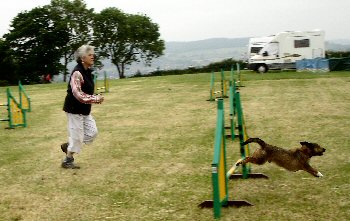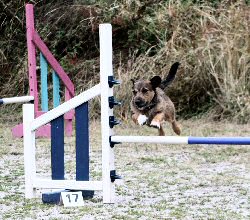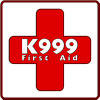| |
Too much of a good
thing...
 Lynn Wetenhall
sent this little article to Agilitynet because she wanted to share her story with
other owners who, like her, might not have realised that they were causing their dog a problem
by constantly throwing / chucking / flinging a ball to their dog. After all, her
dog loved the chase and they were only playing! Thinking back, Lynn is amazed that there isn't more
on the internet and the press about muscle strain, spinal injuries and the other dangers of repetitive ball throwing. Lynn Wetenhall
sent this little article to Agilitynet because she wanted to share her story with
other owners who, like her, might not have realised that they were causing their dog a problem
by constantly throwing / chucking / flinging a ball to their dog. After all, her
dog loved the chase and they were only playing! Thinking back, Lynn is amazed that there isn't more
on the internet and the press about muscle strain, spinal injuries and the other dangers of repetitive ball throwing.
After a slow start to the season, my
rescue terrier X Smudge was starting to do nicely at agility. We were both enjoying
ourselves. He was getting clear rounds and regular places. But over the summer,
he appeared to be less and less keen on agility in both training and at
shows. He started running under the dog walk and lying down there, not wanting
to even go into the ring, running out of the ring - which he had never done
before - or going round extremely slowly. I obviously considered injury as a
reason for this behaviour but, in every other way, he was his normal,
hyper-energetic, frenetic, ball-obsessed, super speedy self. I was about ready
to stop doing agility, thinking that he just didn't like it.
He then limped, just for a day, but a
couple of times in a row, and my trainer noticed that he flinched when she
stroked his lower back. She recommended getting him checked out by
physiotherapist who diagnosed him as having not one but
two chronic conditions – hyper-extended carpal (wrist) joints which, of course,
they use every time they land from a jump as well as completely rigid, strained
lower back muscles. These injuries had clearly been building up over quite a long period
of time.
 What was worse was that she said that the most
likely cause of these injuries was the fact that we had always made too much use of
a ball flinger, doing really huge throws which he would race after. It was his most
favourite thing to do and, as our other dog got older, we made more use of it so
that Smudge got more exercise on a shorter walk. What was worse was that she said that the most
likely cause of these injuries was the fact that we had always made too much use of
a ball flinger, doing really huge throws which he would race after. It was his most
favourite thing to do and, as our other dog got older, we made more use of it so
that Smudge got more exercise on a shorter walk.
I was shocked to hear both the physio and the canine hydrotherapist say that they see
injuries from overuse of ball flingers on a regular basis. It's the
mix of extending straight to a flat out run, skidding to a halt putting strain
on the carpal joints and the twisting in the air to catch balls that does the
damage. She explained that the adrenaline kick in ball chasing for some dogs is
so huge that they overcome the pain and appear normal. Sadly for Smudge,
agility did not provide the same adrenaline kick, and he knew that doing
it was going to be painful, so he was telling me as clearly as he could 'I
don't want to do this.'
The
good news is that a relatively simple programme of two weeks gentle lead
walking, stretch exercises at home, four physio visits and some water treadmill visits pretty much fixed him. He has now been given
an entirely clear health check.
Now, we still throw a ball for him, but he
has to wait until it stops to be released, which means that he doesn't go flat
out as the movement of the ball is what triggers the flat out run. We also hide
it and he enjoys finding it. His agility is very much back on track, and I feel
very grateful to have found out what was going on before he was permanently
damaged.
 Taking stock... Taking stock...
There are several lessons that I have learned from this story:-
- Your dog can have quite serious
injuries but they don't all have obvious symptoms that you can see or notice.
- If your dog's behaviour changes
in relation to agility, think about getting him/her checked by a good physio.
- Don't use ball flingers.
- Do not throw
balls up in the air for your dog.
- A good dog physiotherapist and canine
water treadmill can do wonders for your dog.
Thank you
If my trainer Gwen Johnson hadn't suggested getting Smudge
checked, it would never have occurred to me, being new to the world of dog
sport health and thanks to Rebecca Sharples,
Physio and
Petra Broadbelt,
Hydrotherapist
 About the author... About the author...
Lynn Wetenhall has done
agility with Smudge, her Border Terrier/Jack Russell X, for about three years, after he
chose her at a rescue centre when he was a year old. She continues to love
agility despite having many challenges like a butterfly mind, no persistence or
competitive spirit and poor spatial awareness. However, she loves sitting in
fields at shows, chatting about dogs to others and even doing the odd run.
Lynn lives in Exeter, Devon.
First published 12 December 2016
 K999
first aid... K999
first aid...
As a practising vet I see all sorts of
problems arising from things that have been thrown for dogs. The main two
culprits are sticks and balls. My
advice would be to never throw a stick for your dog. The reason they are a
problem is that they can often land with an end sticking up and, when the dog
reaches it, they lunge on to it and end up lacerating their tongue or throat.
Often all you will see is a small amount of blood from the mouth but there are
often very severe internal injuries that only become apparent when the dog is
anaesthetised.
These wounds can be very difficult to
treat, often because small pieces of stick break off in the depth of the wound,
leading to abscesses in the neck. Do you want to take that risk?
Balls are better but they must be large
enough that the dog cannot swallow it. A tennis ball is okay unless your dog is
very large. Smaller balls can become lodged in the throat and cause
asphyxiation. There often not enough time to get the dog to the vet before the
dog is dead - just as in humans, four minutes without oxygen is fatal.
First published 21 September 2017
| |
|